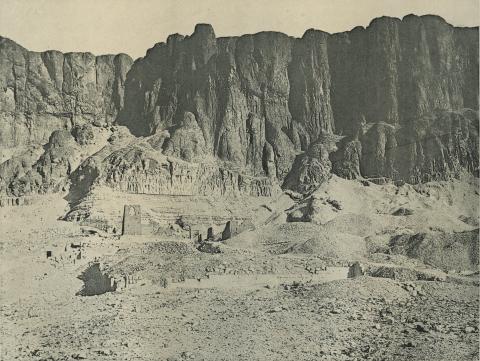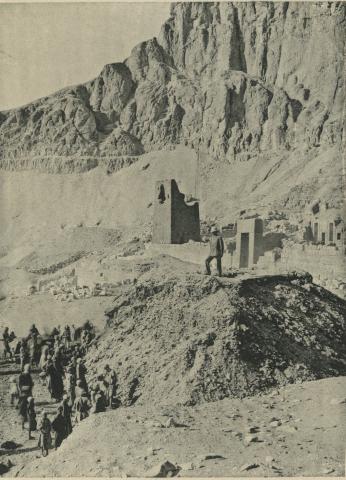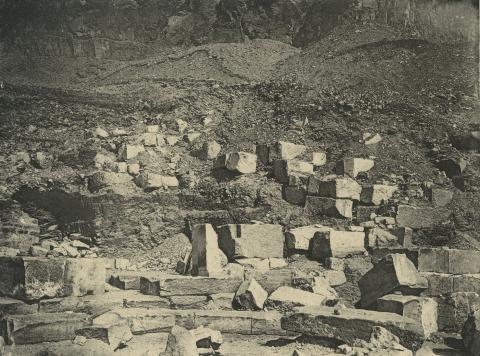This archaeological site is a complex of mortuary temples and tombs located on the west bank of the Nile. It is separated from the Valley of the Kings by the peak of el-Qurn and lies directly across the water from the temple complexes at Karnak and Luxor in Thebes. The site was traditionally connected with the goddess Hathor.
The site includes three mortuary temples of Middle and New Kingdom and several royal and non-royal tombs. The main temples include mortuary temples Mentuhotep II and Hatshepsut, and the temple of Amun by Thutmose III.
In the mortuary temple of Mentuhotep II there were six tombs with shrines for royal ladies with finely carved sarcophagi with scenes of daily life and the presentation of offerings. Many of Mentuhotep’s officials were buried in tombs excavated from the cliffs around his mortuary temple.
The mortuary temple of Hatshepsut is the best preserved of the three, the largest and more impressive at the site. Her temple is clearly inspired by that of Mentuhotep II and was built so that the colonnades at each side of the central ramp correspond with two levels of his mortuary temple. Hatshepsut’s mortuary temple shows signs of adaptation during the Ptolemaic period.
A cache of 163 reburied mummies of the Priest of Amun were also found in a tomb in the Bab el-Gasus area of Deir el-Bahri.
Catalogue of Egyptian antiquities : found by Prof. Flinders Petrie at Ehnasya, Dr. Naville & Mr Hall at Deir el Bahri and Drs Grenfell & Hunt at Oxyrhynchus (Egypt Exploration Fund), Mr Loat at Gurob and drawings from tombs at Saqqara by Misses Murray, Hansard & Mothersole (Egyptian Research Account), 1904 ; exhibited at University College, London, July 4th to 30th. 1904. London.
Catalogue of exhibition of antiquities : found by Dr. Edouard Naville and Mr Hall in the XIth dynasty temple at Deir el-Bahari, season 1904-5 ; exhibited in the library of the Society of Biblical Archaeology, [...], July 3rd to 29th / Egypt Exploration Fund. 1905. London : Egypt Exploration Fund.
Catalogue of exhibition of antiquities and papyri: found by the officers of the Egypt Exploration Fund in the XIth dynasty temple at Deir el-Bahari and at Oxyrhynchus ; exhibited at King's College, Strand, July 10th to August 4th / Egypt Exploration Fund. 1906. London : Egypt Exploration Fund.
Catalogue of an exhibition of antiquities : found by the officers of the Egypt Exploration Fund in the XIth dynasty temple at Deir el-Bahari and at Oxyrhynchus, 1906-7 ; exhibited at King's College, Strand, July 9th to July 30th / Egypt Exploration Fund. 1907. London : Egypt Exploration Fund.
James, T G H 2007. Deir el-Bahari. In Spencer, Patricia (ed.), The Egypt Exploration Society: the early years, 95-129. London; Oxford: Soc.; Oxbow Books.
Naville, Édouard 1894. The temple of Deir el Bahari: its plan, its founders, and its first explorers. Introductory memoir. Memoir of the Egypt Exploration Fund 12. London: Egypt Exploration Fund
Naville, Edouard 1895. The temple of Deir el Bahari, 6 vols. Memoir of the Egypt Exploration Fund [13]; [14]; [16]; [19]; [27]; 29. London: Egypt Exploration Fund.
Naville, Edouard 1907. The XIth Dynasty temple at Deir el-Bahari. Part I. Memoir of the Egypt Exploration Fund 28. London: Egypt Exploration Fund.
Naville, Édouard 1910. The XIth Dynasty temple at Deir el-Bahari. Part II. Memoir of the Egypt Exploration Fund 30. London: Egypt Exploration Fund
Naville, Édouard and H. R. Hall 1913. The XIth Dynasty temple at Deir el-Bahari. Part III. Memoir of the Egypt Exploration Fund 32. London: Egypt Exploration Fund.










